Are you struggling to make the most out of your bathroom space? A well-planned layout not only maximizes functionality but also increases the aesthetic appeal. This article helps demystify ‘bathroom floor plan’ design, offering creative ideas that’ll transform your bath area into a spa-like retreat.
Let’s dive in and start reimagining your bathroom!
The Importance of a Well-Designed Bathroom Floor Plan
A well-designed bathroom floor plan is key to a functional and aesthetically pleasing space. Bathrooms, often smaller than other rooms in the house, require effective space utilization to ensure all necessities fit without making the room feel cramped.
Striking a balance between function and design is crucial! A good layout allows for easy movement while providing necessary amenities like showers, sinks, and toilets.
Maximizing functionality doesn’t mean ignoring beauty though. Creative floor plans can transform your bathroom into an eye-catching element of your home’s interior design. With smart planning and careful use of available space, you can create a bathroom that caters to your practical needs while also offering visual appeal.
The importance of a meticulously planned bathroom cannot be overstated – it adds value not only to everyday living but also increases property worth in the market!

Common Bathroom Floor Plans
In this section, we will explore common bathroom floor plans such as the narrow 50-square-foot bathroom plan, small 48-square-foot full bathroom, spacious 60-square-foot full bathroom, functional 80-square-foot bathroom with tub and shower, compact 17-square-foot half bath, and the basic three-quarter bathroom layout.

Narrow 50-square-foot bathroom plan
Despite its compact dimensions, a narrow 50-square-foot bathroom plan holds plenty of potentials. This layout typically features a five by ten feet space with a shower at the far end.
Its slim footprint, surprisingly, is not a drawback but is favored in many homes due to clever design solutions that utilize every inch wisely.
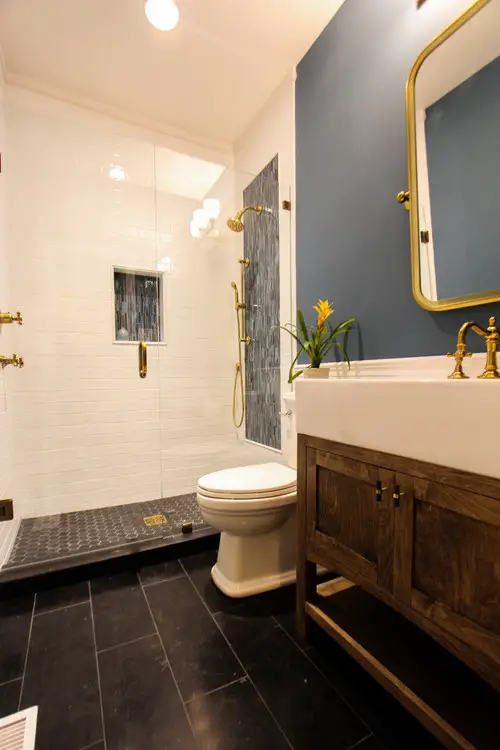
In such bathrooms, you’ll often find innovative storage options and strategically placed fixtures that enhance functionality without cramping the area. Modern designs even incorporate chic elements like floating vanities or glass shower enclosures that lend an illusion of more space.
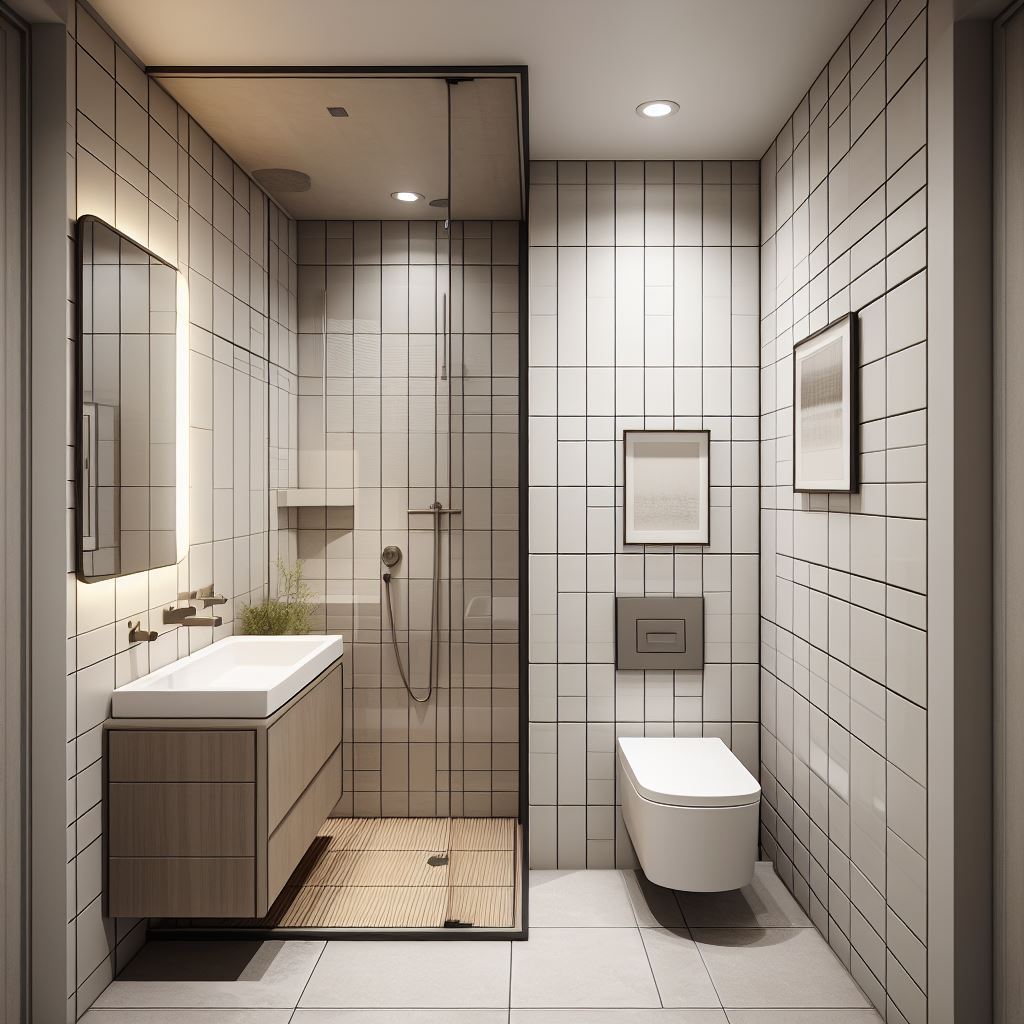
So if your house has this type of compact bathroom layout to contend with, fear not – there are numerous ways to create an efficient and stylish haven within these confines!
Small 48-square-foot full bathroom
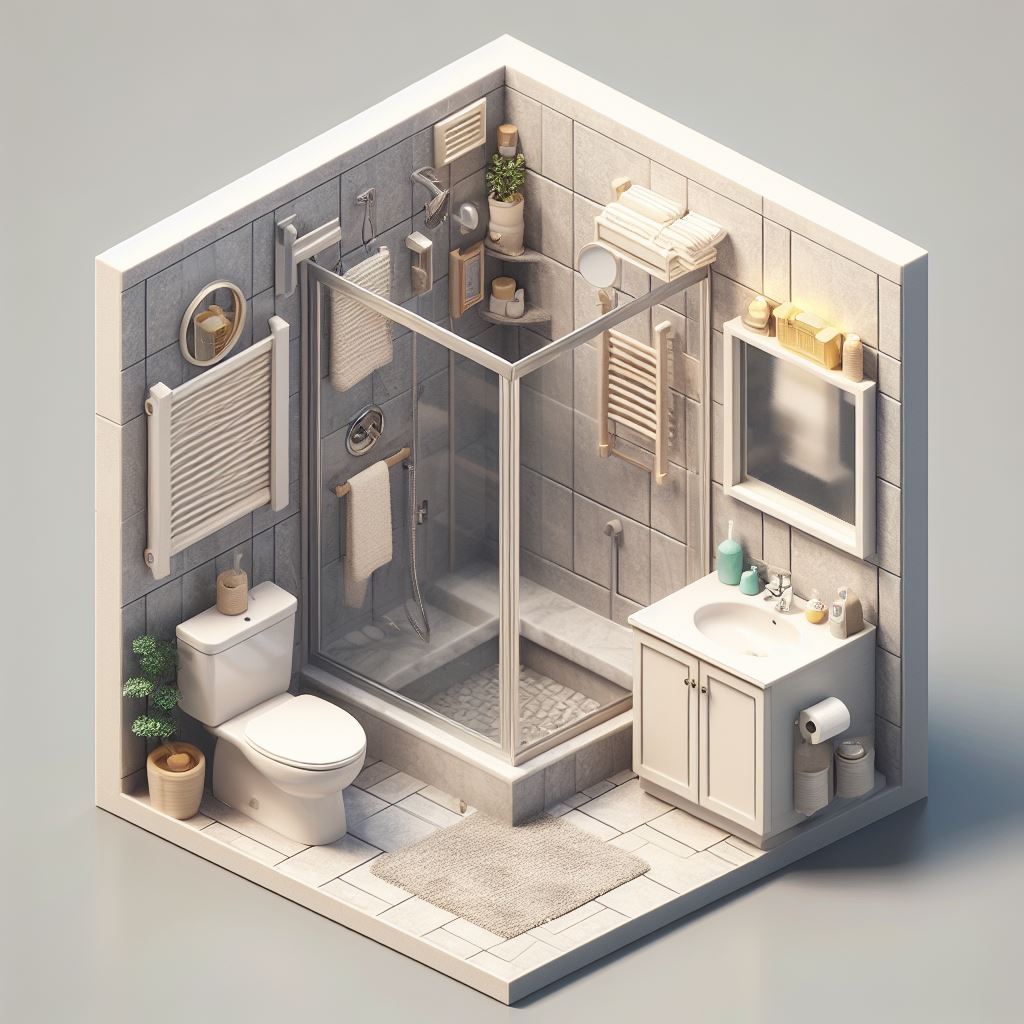
Every nook and corner of a small 48-square-foot full bathroom holds significant potential. Space-saving bathroom ideas focus on clever ways to fit a toilet, tub, and sink into this limited area without compromising comfort or style.
Vertical storage solutions are your best friend in such scenarios, allowing you to utilize every inch effectively. Mirrors create an illusion of extensive space, while wall-mounted fixtures free up floor space.
Make use of light hues for tiles and paint to give the room an airy feel and add depth where there’s none really available. Compact bathroom design strategies like these transform tiny bathrooms into functional spaces that never make their size apparent.
These budget-friendly remodeling tricks can work wonders for brightening compact areas while creating a feeling of ample space no matter how constrained it may be.
60-square-foot full bathroom
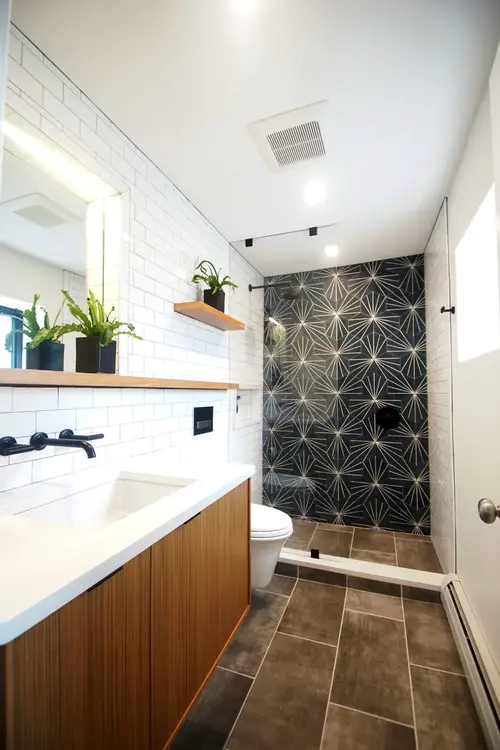
A 60-square-foot full bathroom is an efficient and practical space for optimizing functionality. With this compact bathroom design, the sink and toilet are strategically placed on opposite ends facing each other, maximizing convenience and accessibility.
This floor plan allows for creative bathroom makeovers within limited square footage, making it a great option for small spaces or nontraditional layouts. Whether you choose to include a wall-mount design or incorporate innovative storage solutions, a 60-square-foot full bathroom can greatly improve the functionality of your space without sacrificing style or efficiency.
80-square-foot bathroom with tub and shower
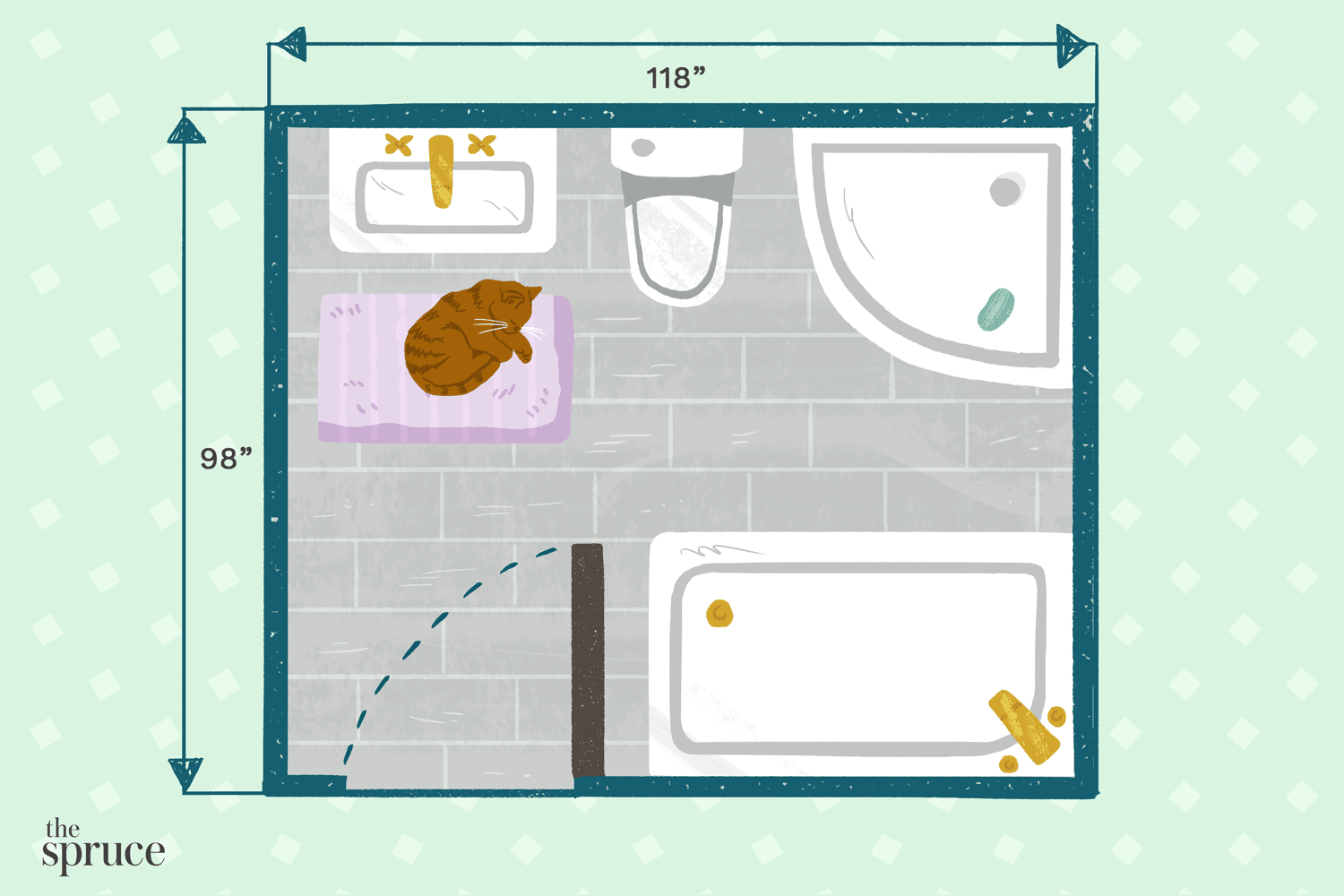
The 80-square-foot bathroom with a tub and shower is a popular choice for homeowners looking to maximize space and functionality. It is part of the creative bathroom floor plan ideas to optimize small bathroom spaces.
This layout offers the convenience of having both a tub and shower in one compact area, making it perfect for individuals or families with limited square footage in their bathrooms.
With careful planning, this size can still accommodate essential fixtures like a vanity, toilet, and storage options without feeling cramped. The 80-square-foot bathroom with a tub and shower provides homeowners with an efficient and practical layout that meets their needs while maximizing every inch of available space.
Tiny 17-square-foot half bath
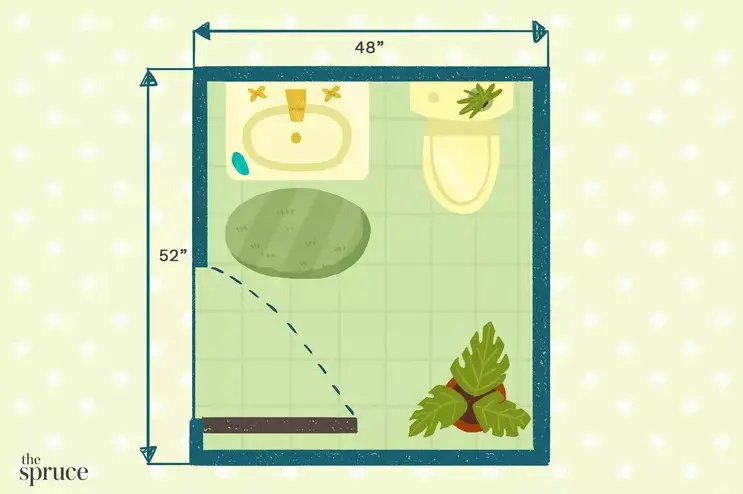
Designing a functional and stylish bathroom layout for your tiny 17-square-foot half bath can be a challenge, but with some creative planning, you can maximize the limited space. Consider installing a corner sink to save space and open up the room.
Opt for a wall-mounted toilet to create more floor space and make the area feel larger. Utilize vertical storage options such as floating shelves or cabinets above the toilet to keep essentials organized without taking up precious room.
Incorporate light colors and mirrors into the design to enhance natural light and create an illusion of more space. By carefully considering every element in your small bathroom, you can transform it into a functional and visually appealing oasis.
Efficiently utilizing every inch of your compact bathroom layout is essential when designing your tiny 17-square-foot half bath. With strategic storage solutions like recessed shelving or built-in niches, you can maximize functionality while maintaining a sleek aesthetic.
Consider installing a pocket door instead of a swinging one to free up even more space in this small area. Adding adequate lighting, such as overhead fixtures or wall sconces, will help brighten up the room and make it appear larger than it actually is.
Basic three-quarter bathroom

A basic three-quarter bathroom floor plan includes three of the four essential bathroom components, making it a functional and practical option for smaller spaces. Despite its simplicity, there are still plenty of ways to enhance the design and maximize functionality.
With creative layout ideas and clever storage solutions, you can transform your basic three-quarter bathroom into a stylish oasis that meets all your needs. Whether you’re looking to add extra counter space or incorporate a luxurious shower, explore the countless possibilities to make the most out of your limited square footage.
Maximizing Space: Creative Floor Plan Ideas
Maximize the functionality and space in your bathroom with creative floor plan ideas that will transform the way you use and enjoy this essential space in your home.
Features for functionality (such as bump-out alcove for tub)
A bump-out alcove for the tub is a space-saving feature that maximizes functionality in bathroom floor plans. This design element creates an organized and efficient bathroom layout by providing a designated area for the tub, making it a focal point of the room.
The customizable alcove can be designed in various sizes and shapes to fit the specific needs and preferences of the homeowner. It can also be combined with other functional features like built-in storage or seating nooks, offering even more versatility and convenience in your bathroom design.
Awkward room shape solutions
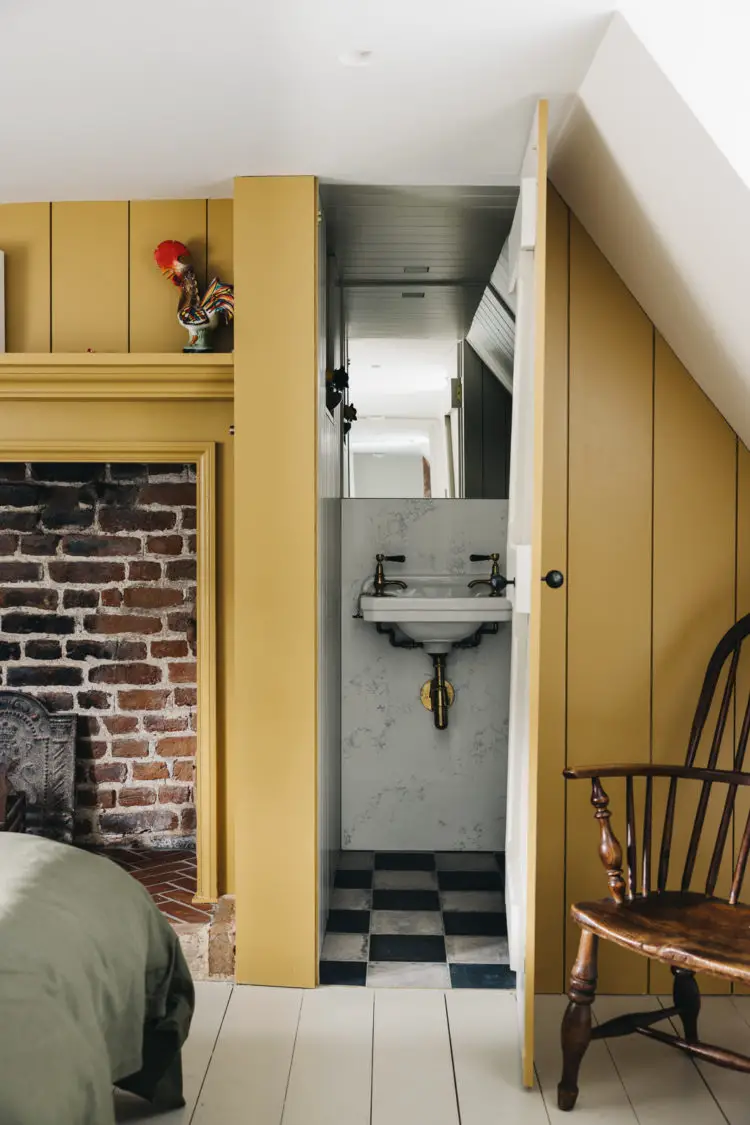
Dealing with an awkward room shape in your bathroom can be challenging, but there are expert solutions available to help you make the most of your space. One approach is to utilize interesting colors and finishes to draw attention away from the odd layout.
By choosing wall-hung designs, you can save valuable floor space and create a more streamlined look. Additionally, maximizing bathroom storage in awkwardly shaped layouts can completely transform the functionality of the room.
With practical tips and techniques, it’s possible to optimize even the most challenging room layouts and make every inch count.
Private toilet placement
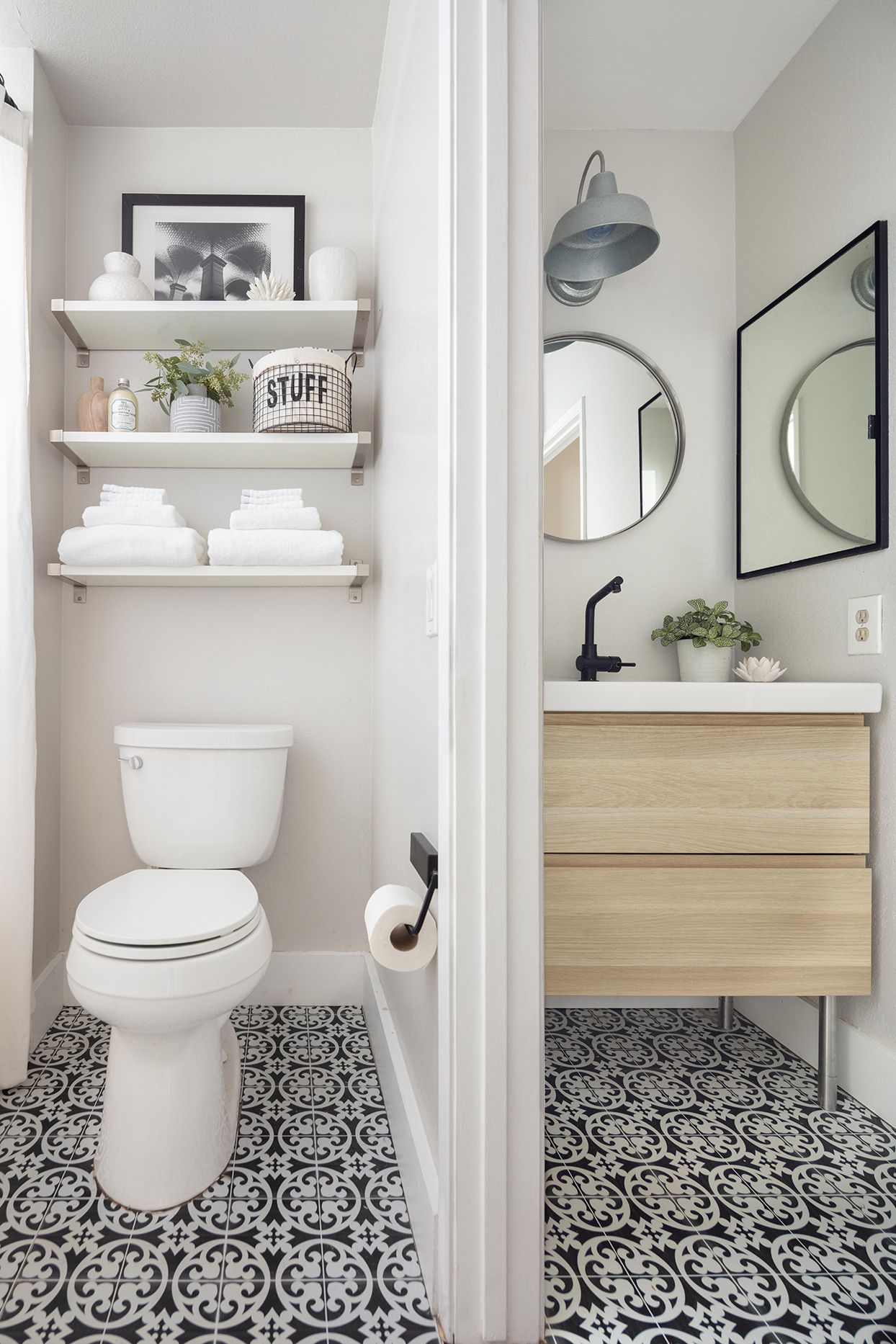
In a well-designed bathroom floor plan, it is crucial to consider the placement of the toilet for functionality and privacy. A separate area or enclosure for the toilet provides a sense of privacy while allowing other parts of the bathroom to be used by someone else simultaneously.
This private space ensures that individuals can use the toilet without interrupting others who may be in different areas of the bathroom. Additionally, placing the toilet strategically can contribute to maximizing available space and optimizing the overall layout of the bathroom.
By considering factors such as door swing elimination and utilizing wall-mounted toilets, you can create a more open and spacious feel in your bathroom design. Remember, private toilet placement is not only essential for practicality but also contributes to creating a comfortable and functional space.
Storage room addition
Maximizing storage space in your bathroom is essential for keeping it organized and clutter-free. One creative floor plan idea is to add a storage room to your bathroom design. This additional room can be built adjacent to the main bathroom area and can serve as a dedicated space for storing towels, linens, toiletries, cleaning supplies, and other items.
By incorporating a storage room into your floor plan, you can optimize the use of vertical space while keeping everything within easy reach. Built-in shelving and cabinets can be installed to maximize storage capacity and keep items neatly organized.
With a storage room addition, you can enjoy an efficient use of space while ensuring that all your bathroom essentials are conveniently stored away.
Open floor space design
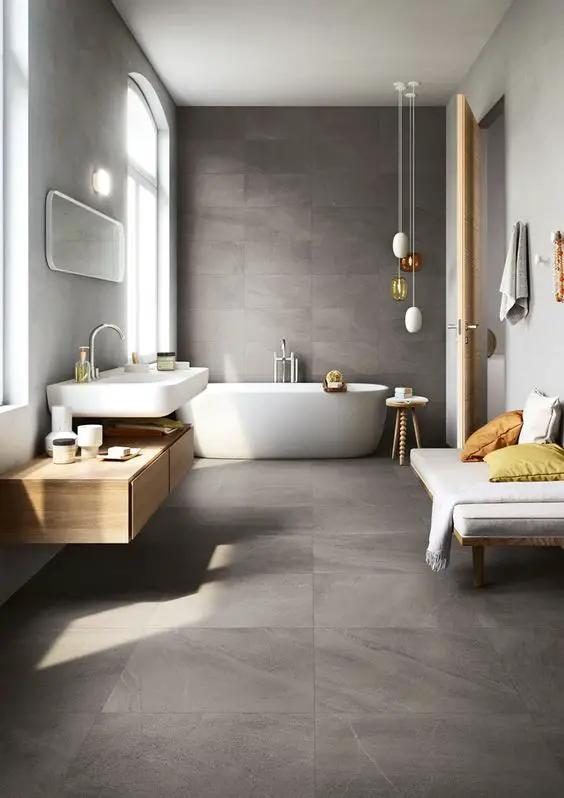
Open floor space designs are popular for their ability to maximize square footage and create a sense of spaciousness in a bathroom. By removing walls and barriers, an open floor plan allows for easy movement and communication flow between different areas of the bathroom.
This design concept is especially beneficial in small bathrooms, as it can make the space feel larger and more open. Additionally, an open floor plan provides flexibility in terms of furniture placement and room organization.
With proper lighting and airflow, an open floor space design can enhance both functionality and aesthetics in your bathroom.
Fun and simple kids’ bathroom
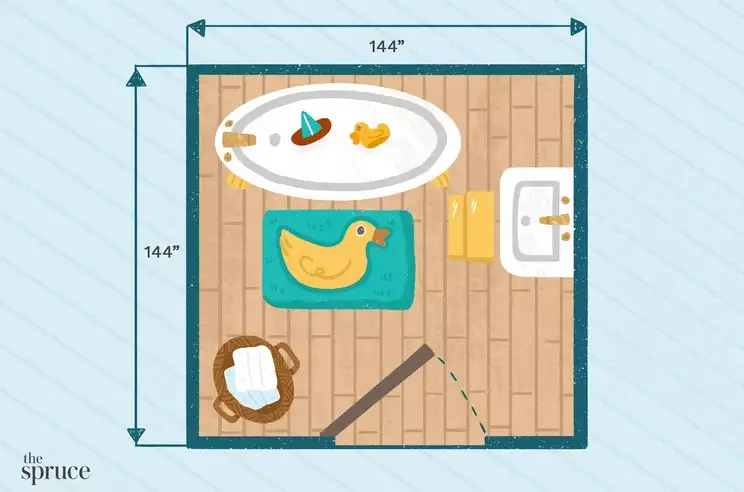
Designing a fun and simple kids’ bathroom is all about creating an engaging space that children will love. Incorporating playful elements into the floor plan can make bath time more enjoyable for little ones.
Consider adding colorful tiles or vibrant wallpapers to create a lively atmosphere. It’s also important to maximize space and functionality by incorporating innovative storage options, such as built-in shelving or under-the-sink cabinets, to keep toys and essentials organized.
Additionally, including child-friendly features like step stools or adjustable showerheads can make it easier for kids to use the bathroom independently. By combining creativity with practicality, you can transform your kids’ bathroom into a space that they’ll always enjoy spending time in.
A fun and simple kids’ bathroom should be designed with accessibility in mind. To optimize the layout, consider placing items within easy reach of children so they can develop independence while using the facilities.
Including low-height sinks, toilets, and countertops will make it easier for young ones to take care of their own hygiene needs. For added excitement, incorporate interactive elements such as wall-mounted games or chalkboard paint where children can unleash their creativity during bath time.
Factors to Consider in Bathroom Floor Plan Design
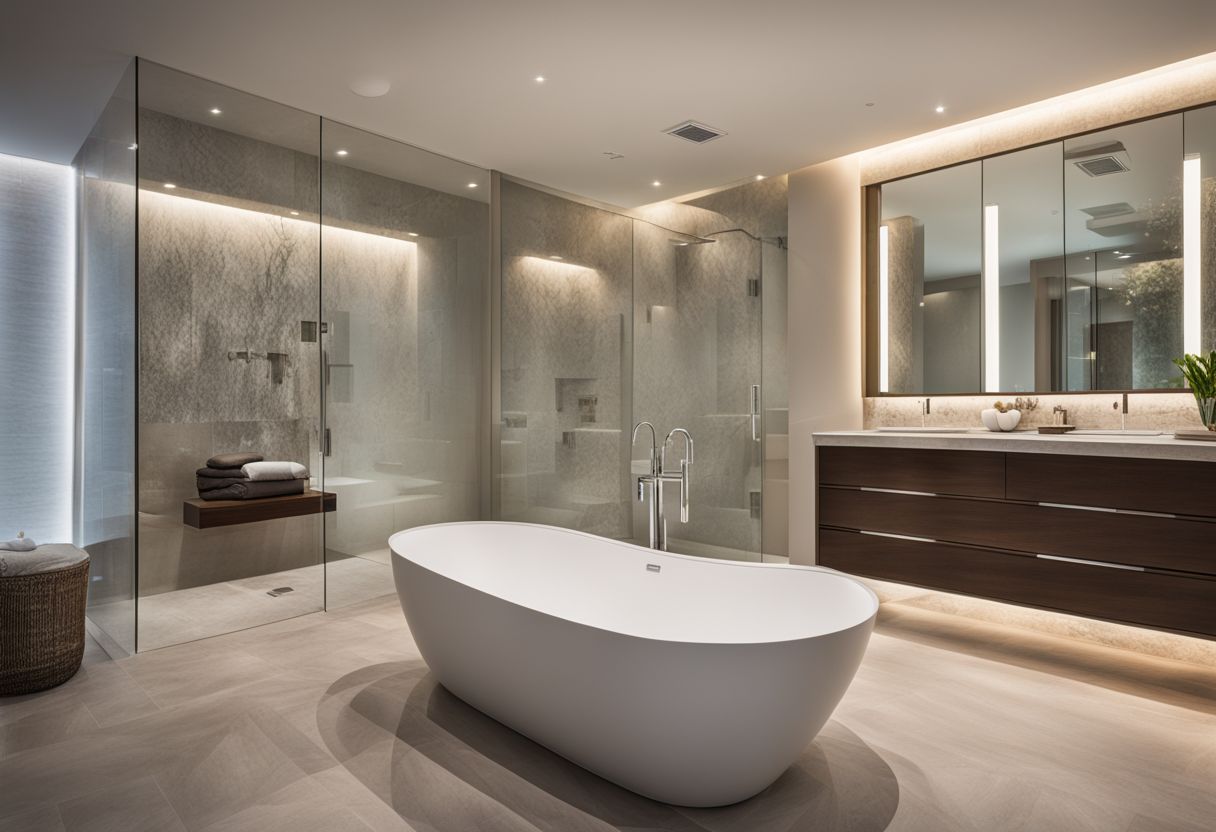
Consider the codes and guidelines for tub size, shower size, door entry, ventilation, sink and lighting placement. Think about who will use the bathroom and how, as well as popular bathroom layouts for different needs.
To ensure a well-designed bathroom floor plan, it’s important to consider codes and guidelines for various elements. Take note of these factors when planning your tub size, shower size, door entry, ventilation, sink placement, and lighting placement:
- A clear floor space of at least 30″ is recommended from the front edge of all fixtures to any opposite bath.
- Toilet clearance code requirements are often overlooked during bathroom remodels and should be taken into consideration.
- Shower doors and panels should be made from tempered glass and placed at least 15″ from the center of the toilet flange.
- Ventilation regulations should be followed to maintain air quality in the bathroom.
- Sink placement should prioritize functionality and accessibility.
- Proper lighting positioning is important to create a well – lit and functional bathroom space.
Consideration must be given to who will use the bathroom and their specific needs when designing the floor plan. This includes taking into account user requirements, accessibility needs, occupant demographics, and user preferences.
By understanding who will be using the bathroom and how it will be utilized, you can create a functional design that meets everyone’s needs while maximizing space and ensuring safety.
Additionally, storage requirements should be considered, as well as any budget constraints that may impact the design choices. Ultimately, creating a bathroom floor plan that caters to the users’ needs is essential for a successful and efficient space.
Popular bathroom layouts for different needs
There are various bathroom layouts available to suit different needs and preferences. When designing your bathroom floor plan, it’s essential to consider who will be using the space and how they will use it.
For small bathrooms, a narrow 50-square-foot or a small 48-square-foot full bathroom layout can save space while still providing all necessary fixtures. If you have more room to work with, options like a 60-square-foot full bathroom or an 80-square-foot bathroom with a tub and shower offer more luxury.
And for those tight on space, a tiny 17-square-foot half bath might be just what you need. Whatever your requirements may be, there is a popular bathroom layout that can meet them while optimizing both space and functionality.
In addition to considering the size of your bathroom and its intended users, other factors should also influence your choice of layout. Codes and guidelines for tub size, shower size, door entry, ventilation, sink placement, and lighting should all be taken into account for safety and convenience purposes.
Floor Plan Examples and Inspiration
Get inspired by these floor plan examples to create a functional and stylish bathroom design that maximizes space and meets your needs: from small layouts without tubs, to versatile primary bathrooms, to dreamy spacious plans with luxurious features.
Three-quarter bath layout without tub
A three-quarter bath layout without a tub is an efficient and space-saving option for smaller bathrooms. This type of floor plan typically includes a standing shower, sink, and toilet.
By eliminating the bathtub, you can maximize the available space and create a more functional bathroom layout. Whether you have limited square footage or simply prefer showers over baths, this design allows you to make the most of your bathroom’s size while still providing all the necessary fixtures for daily use.
Full bath layout
Designing a full bath layout requires careful consideration to maximize both space and functionality. With 99 bathroom layouts available in three-dimensional imagery, you can find inspiration for your dream bathroom design.
QS Supplies showcases various options, including versatile primary bathroom layouts and large primary bathroom plans. WarmlyYours offers 101 floor plans to help you pick the best layout for your nontraditional bathroom space.
By budgeting and considering design considerations, such as codes guidelines and popular layouts for different needs, you can create a stunning full bath that meets all your requirements.
Versatile primary bathroom layout
The versatile primary bathroom layout offers a range of possibilities to suit your unique style and needs. With this floor plan, you have the freedom to create a space that is both functional and stylish.
Whether you prefer a spacious oasis or a cozy retreat, the versatile primary bathroom layout can accommodate your vision. You can choose from various design options such as separate shower and bathtub, double sinks for added convenience, or even incorporate additional storage solutions to maximize organization.
This flexible floor plan allows you to customize your bathroom based on your preferences while maintaining functionality and efficiency. Explore the diverse bathroom layout options available with the versatile primary bathroom design and let your creativity shine in creating a space that truly reflects your personal taste.
Large primary bathroom plan
Designing a large primary bathroom requires careful consideration to make the most of the space. As you plan your layout, think about incorporating features like a double vanity and separate shower and tub areas for added luxury.
Consider creating distinct zones within the bathroom for different functions, such as a makeup area or seating area. With a spacious floor plan, you have plenty of room to get creative and design a truly stunning and functional primary bathroom that meets all your needs.
Dream primary bathroom floor plan
Designing your dream primary bathroom starts with creating the perfect floor plan. This is the foundation for a space that combines functionality and luxury. Consider features like a spacious shower, a separate soaking tub, his and hers sinks, and ample storage.
With careful planning, you can create a layout that maximizes space while reflecting your unique style and needs. Use the examples provided in this article as inspiration to bring your dream primary bathroom to life.
Additional bathroom layout ideas for privacy, vanity, and tub placement
Looking for additional bathroom layout ideas to maximize privacy, vanity placement, and tub placement? Here are some suggestions:
- Separate toilet area: Create a separate enclosed space for the toilet to provide privacy while allowing others to use the sink or shower.
- Vanity nook: Design a vanity nook by using a corner of the bathroom to place the sink and mirror, maximizing floor space.
- Tub with a view: Install a freestanding tub near a window, offering both privacy and a relaxing view.
- Tub shower combo: Combine the tub and shower in one area to save space while still enjoying the benefits of both.
- Pocket doors: Use pocket doors instead of traditional swinging doors to save space and improve flow in smaller bathrooms.
- Shower niche storage: Incorporate built-in shelving or niches in the shower area for storing toiletries, eliminating clutter from countertops.
- His and hers vanities: Consider installing double sinks or separate vanities for couples or families who need their own personal space.
- Freestanding storage units: Opt for freestanding storage units that can be moved around as needed, providing flexibility in organizing bathroom essentials.
Code Requirements for Bathroom Design
Learn about the important code requirements for bathroom design to ensure your space meets safety and functionality standards.
When designing your bathroom floor plan, there are several important factors to consider. First, ensure that the door entry allows for easy access and is wide enough for wheelchair users if necessary.
Clear bathroom space is essential for maneuverability, so make sure there is enough room between fixtures and walls to comply with code requirements. Adequate space should be allocated for single or double lavatory placement to allow for comfortable use.
The size of the shower should accommodate your needs while adhering to building codes. When determining the location of the toilet and bidet, keep in mind the required clearances and distances from other fixtures.
Consider incorporating a separate toilet compartment for privacy if space allows. Effective storage solutions are crucial in maintaining an organized bathroom; plan for built-in shelves or cabinets based on your storage needs.
More Info About Bathroom Floor Plans

When considering bathroom floor plan ideas, especially for a small space, it’s essential to strategize for the most efficient layout. One of the most common bathroom layouts for older homes, especially those with limited square feet, is the half bathroom or powder room. This design primarily includes a toilet and sink, and it’s a great way to maximize functionality in a narrow bathroom space. These half baths are often situated near the home’s entrance or in a corner, serving as a guest bathroom.
On the other hand, if you’re working with a slightly larger area, integrating a shower combination or even a free-standing tub might be a good option. For those prioritizing privacy, incorporating a separate room or partition wall for the water closet, often referred to as a toilet room, can be a great idea. This ensures that during the morning rush hour, one person can use the shower while another uses the toilet, promoting efficiency.
In larger homes, the master bathroom often becomes the center of attention. Spanning a larger floor area, these bathrooms provide enough space for double sinks on opposite walls, a boon for couples who don’t want to jostle for countertop space. A walk-in shower with a sleek glass door can be placed adjacent to a luxurious free-standing tub, ensuring both dry zones and wet zones are defined.
It’s a good idea to position these fixtures near an exterior wall, allowing for natural light to filter in, enhancing the ambiance. For those desiring a bit more luxury and have the floor tile area to spare, a wet room, which is essentially a shower area that doesn’t need a curtain or door, could be considered. This kind of layout, often found in stylish spaces, features a shower head directly installed in the ceiling, creating a rain-like experience.
As bathrooms have evolved, so have the general ideas surrounding their design. For instance, corner showers are a fantastic solution for smaller bathrooms, ensuring you utilize every bit of space. On the opposite end of the spectrum, a large bathroom can accommodate a central storage cabinet, perfect for stashing away towels, toiletries, and more. Door openings, especially sliding doors, can also play a pivotal role in determining the flow of the bathroom.
Interior designers often suggest having a bathroom template at hand when planning a new bathroom design, as this helps visualize the placement of bathroom fixtures and ensures you maintain the minimum size requirements, such as toilet dimensions and bathroom sizes. Lastly, always remember to install a towel rack within arm’s reach of your shower or tub, ensuring convenience and a touch of elegance.
Conclusion
Discover endless possibilities for maximizing space and functionality with these creative bathroom floor plan ideas. From storage solutions to innovative layouts, you can transform your bathroom into a practical and stylish oasis.
Don’t settle for a cramped or inefficient design – let your imagination run wild and create the bathroom of your dreams!
FAQs
1. How can I maximize space in my bathroom with a creative floor plan?
You can maximize space in your bathroom by using clever design ideas such as installing wall-mounted storage, opting for a corner shower, or utilizing vertical storage solutions.
2. Are there any specific measurements I should consider when planning a bathroom floor plan?
Yes, it is important to measure the dimensions of your bathroom accurately before designing a floor plan. This will help you determine the best placement and sizing of fixtures like the toilet, sink, and shower.
3. What are some functional features I can incorporate into my bathroom floor plan?
Some functional features you can include in your bathroom floor plan are ample lighting, efficient ventilation systems, easy-to-clean surfaces, and well-placed electrical outlets for appliances and grooming tools.
4. Can I make my small bathroom feel more spacious with a creative floor plan?
Yes, you can make your small bathroom feel more spacious by utilizing smart storage solutions like recessed shelves or built-in cabinets and choosing light colors for walls and fixtures to create an illusion of openness.
5. Should I consult with a professional designer when creating a creative floor plan for my bathroom?
While it’s not necessary to consult with a professional designer, seeking advice from an experienced interior designer or architect can provide valuable insights and ensure that your chosen layout maximizes both space and functionality in your bathroom design.


